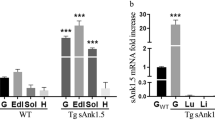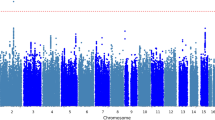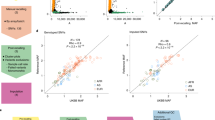Abstract
OBJECTIVE: UCP2 and UCP3 are newly discovered uncoupling proteins, which are thought to underlie the variability in energy metabolism in humans. Mutations in the UCP2 and/or UCP3 gene have been associated with sleeping metabolic rate. Recently we reported that skeletal muscle UCP3 mRNA expression was positively correlated with sleeping metabolic rate in Pima Indians. To study whether genetic variation in the promoter region of UCP3 contributed to the variation in expression of UCP3, we screened part of the proximal promoter region for polymorphisms.
METHODS: In the first part of the study, the proximal promoter region of UCP3 was screened by direct sequencing in 24 non-diabetic Pima Indians (range body mass index (BMI): 18–47 kg/m2) (Schrauwen et al. Diabetes 1999; 48: 146–149) and skeletal muscle UCP3 mRNA expression was measured by RT-PCR. In the second part of the study, we typed the polymorphism found in the first part of the study in 67 Pima Indians (32 males, 35 females) from the upper and lower extremes of the BMI distribution.
RESULTS: We identified a novel C to T substitution in the UCP3 promoter, 6 bp upstream of the putative TATA signal, and 55 bp upstream of the transcription starting site. Among 18 male subjects, skeletal muscle UCP3 mRNA expression was significantly higher in the C/T & T/T group compared to the C/C homozygotes (P<0.02). However, in the group of 67 Pima Indians genotype frequencies were not different in the obese and lean groups.
CONCLUSION: We identified a novel polymorphism in the proximal promoter region of UCP3, which was associated with increased skeletal muscle expression of UCP3 in male non-diabetic Pima Indians. Considering the suggested role of UCP3 in energy metabolism, this polymorphism might be of physiological importance in the regulation of energy balance.
This is a preview of subscription content, access via your institution
Access options
Subscribe to this journal
Receive 12 print issues and online access
$259.00 per year
only $21.58 per issue
Buy this article
- Purchase on Springer Link
- Instant access to full article PDF
Prices may be subject to local taxes which are calculated during checkout
Similar content being viewed by others
Author information
Authors and Affiliations
Corresponding author
Rights and permissions
About this article
Cite this article
Schrauwen, P., Xia, J., Walder, K. et al. A novel polymorphism in the proximal UCP3 promoter region: effect on skeletal muscle UCP3 mRNA expression and obesity in male non-diabetic Pima Indians. Int J Obes 23, 1242–1245 (1999). https://doi.org/10.1038/sj.ijo.0801057
Received:
Revised:
Accepted:
Published:
Issue Date:
DOI: https://doi.org/10.1038/sj.ijo.0801057
Keywords
This article is cited by
-
Association of uncoupling protein (Ucp) gene polymorphisms with cardiometabolic diseases
Molecular Medicine (2020)
-
Candidate gene association study of UCP3 variant rs1800849 with T2D in Mizo population of Northeast India
International Journal of Diabetes in Developing Countries (2020)
-
Association of uncoupling protein gene polymorphisms with essential hypertension in a northeastern Han Chinese population
Journal of Human Hypertension (2019)
-
Examining for an association between candidate gene polymorphisms in the metabolic syndrome components on excess weight and adiposity measures in youth: a cross-sectional study
Genes & Nutrition (2017)
-
Single nucleotide polymorphisms linked to mitochondrial uncoupling protein genes UCP2 and UCP3 affect mitochondrial metabolism and healthy aging in female nonagenarians
Biogerontology (2016)



